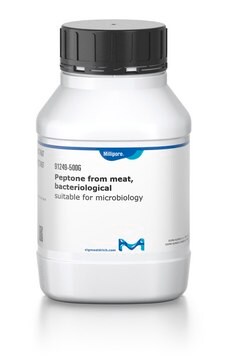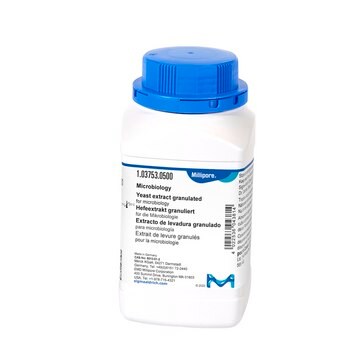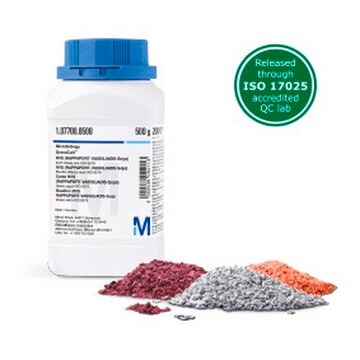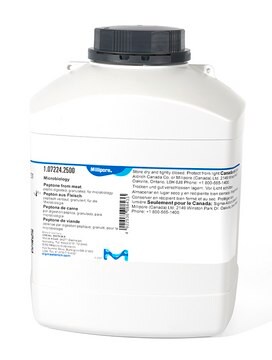1.07043
Universal peptone M 66
suitable for microbiology
Synonim(y):
Poly peptone, peptone mixture
Zaloguj sięWyświetlanie cen organizacyjnych i kontraktowych
About This Item
Kod UNSPSC:
41106212
NACRES:
NA.74
Polecane produkty
Postać
powder
Poziom jakości
opakowanie
pkg of 1 kg
pH
6-7 (20 g/L in H2O)
rozpuszczalność
490 g/L
gęstość nasypowa
370 kg/m3
Zastosowanie
microbiology
temp. przechowywania
15-25°C
Powiązane kategorie
Opis ogólny
Universal M 66 peptone is a poly peptone mixture of casein peptone, meat peptone and soy peptone, with well-balanced nutritional characteristics. Peptone M 66 is widely used in industrial microbiology as a nutrient source for the growth of microorganisms in large-scale fermentation processes. Peptone M 66 is a water-soluble protein hydrolysate obtained by the digestion of natural sources such as meat, casein, gelatin, or soy. It provides a variety of essential nutrients required for bacterial growth, including amino acids, vitamins, and minerals. It is useful for the growth of fastidious bacteria, yeasts, and molds.
Zastosowanie
Universal peptone M 66 can be used as nutrient, for example as replacement of serum albumin in cell culture and fermentation. It is commonly used as an ingredient in many microbial culture media for the growth and identification of bacteria, yeasts, and molds from various pharmaceutical, environmental, and food and beverage samples.
Komentarz do analizy
Peptone content (ex N, calc. on dried substance): ≥ 80 %
Amino nitrogen (as N): ≥ 3.5 %
pH-value (2 %; water): 6 - 7
Sulfated ash (800 °C): ≤ 15 %
Heavy metals (as Pb): ≤ 0.001 %
Loss on Drying (105°C): ≤ 5 %
Suitability for microbiology: passes test
Amino nitrogen (as N): ≥ 3.5 %
pH-value (2 %; water): 6 - 7
Sulfated ash (800 °C): ≤ 15 %
Heavy metals (as Pb): ≤ 0.001 %
Loss on Drying (105°C): ≤ 5 %
Suitability for microbiology: passes test
This page may contain text that has been machine translated.
Kod klasy składowania
11 - Combustible Solids
Klasa zagrożenia wodnego (WGK)
WGK 1
Certyfikaty analizy (CoA)
Poszukaj Certyfikaty analizy (CoA), wpisując numer partii/serii produktów. Numery serii i partii można znaleźć na etykiecie produktu po słowach „seria” lub „partia”.
Masz już ten produkt?
Dokumenty związane z niedawno zakupionymi produktami zostały zamieszczone w Bibliotece dokumentów.
Nasz zespół naukowców ma doświadczenie we wszystkich obszarach badań, w tym w naukach przyrodniczych, materiałoznawstwie, syntezie chemicznej, chromatografii, analityce i wielu innych dziedzinach.
Skontaktuj się z zespołem ds. pomocy technicznej








